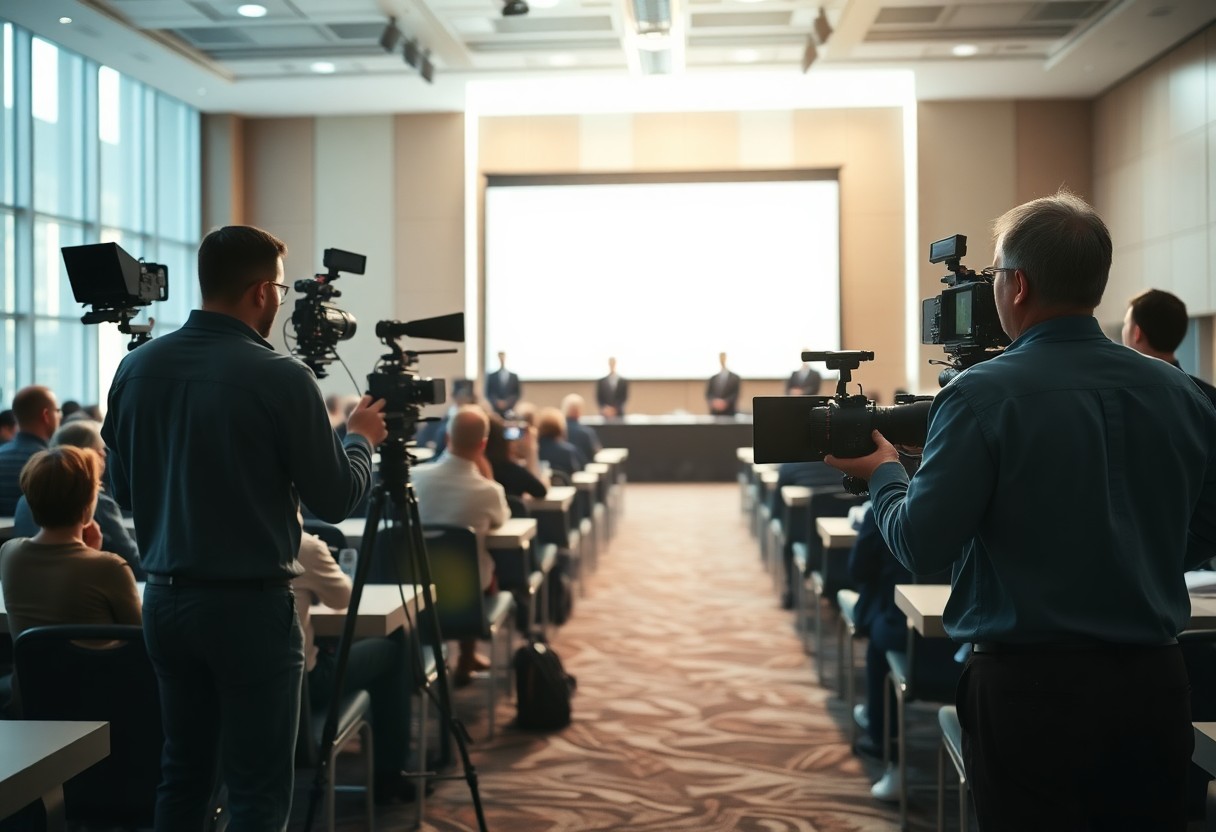Over the years, effective event videography has transformed corporate conferences into engaging visual experiences that resonate with audiences. In this guide, you will learn how to elevate your event with professional videography services, ensuring you capture every crucial moment. From selecting the right videography team to planning your shoot’s logistics, this comprehensive how-to will provide you with the insights needed to maximize your investment and create memorable content for your brand.
Understanding Event Videography
The importance of event videography in capturing the essence of corporate conferences cannot be overstated. It provides a lasting record of presentations, discussions, and networking opportunities, allowing your company to showcase its professionalism and innovation. High-quality video content can also enhance your brand’s visibility and engage audiences beyond the event, making it a valuable tool for marketing and internal communications.
Importance of Videography in Corporate Conferences
Clearly, effective videography elevates your corporate conferences by ensuring that valuable moments are preserved for future reference. It enhances engagement for absent attendees and generates promotional material for stakeholders.
Key Factors to Consider Before Hiring Videography Services
There’s an array of factors to keep in mind when hiring videography services for your conference. Evaluate the service provider’s experience, equipment, and portfolio. Consider their availability and how they adapt to your specific needs. The quality of their editing work and the timeliness of delivery are equally important.
- experience
- equipment
- portfolio
- availability
- adaptability
Corporate video production is a multifaceted process that weaves together your event’s vision and goals. Discuss your expectations thoroughly with the videographer, ensuring they understand your specific objectives, desired style, and budget. A direct line of communication will foster a smoother collaboration and enhance the final product’s quality. Thou must make informed choices to ensure your conference is well-documented.
- objectives
- style
- budget
- communication
- collaboration
Planning Your Videography Strategy
Some key elements to consider while Planning A Successful Corporate Event Video Production are the goals, timelines, and expectations for the shoot. You should thoroughly evaluate the type of content you wish to capture and think about the narrative you want to convey. Having a well-defined plan will ensure that your videography effectively captures the essence of your corporate conference and meets your business objectives.
Setting Clear Objectives for Your Event Videography
Even the best filming techniques won’t matter if you haven’t established clear objectives. You should determine what you want to achieve with your event video, whether it’s enhancing brand awareness, creating training material, or documenting key moments for future reference. Clarity in your goals will guide the entire production process.
Budgeting for Videography Services
If you want to make informed decisions, establishing a realistic budget for your videography services is crucial. Include factors such as equipment, crew fees, post-production costs, and any additional services you may require. Aim for a balanced approach to ensure quality without overspending.
Planning your budget effectively involves accounting for unexpected expenses as well. You may encounter additional costs related to travel, permits, or even the venue itself, which can impact your overall expenditure. Allocating a portion of your budget for contingencies is a wise strategy. This way, you’ll be prepared to handle any surprises that may arise, ensuring your event videography proceeds smoothly and you achieve your targeted outcomes.
Choosing the Right Videography Team
Even with numerous options available, selecting the right videography team for your event is vital to achieving outstanding results. To explore How to Bring Your Next Event to Life with Videography, consider the styles and expertise of different teams, ensuring they align with your vision and objectives.
Tips for Evaluating Videographers
For a successful selection process, keep these tips in mind:
- Review their portfolio for quality and style.
- Check customer testimonials for reliability and professionalism.
- Ask about their experience with corporate events.
- Discuss the types of equipment they use for high-quality production.
Any good team should be flexible, communicative, and eager to meet your needs.
Questions to Ask Potential Videography Teams
Videographers should be prepared to answer specific questions about their services and experience. Inquire about their process for capturing live events, how they manage multiple camera angles, and their approach to editing and post-production timelines. Ask for examples of how they’ve handled challenges at previous events. This inquisitive approach will help you gauge their expertise and adaptability in various situations.
Videography plays a significant role in enhancing the impact of your conference. A team that demonstrates a clear understanding of your goals and the ability to create a compelling narrative will greatly influence the final product. It’s vital to discuss any potential obstacles they foresee and ensure they have contingency plans in place to address them. This depth of preparation reveals their professionalism and commitment to delivering exceptional outcomes.
Preparing for the Event
For a successful event videography experience, thorough preparation is important. Begin by gathering all relevant information about the conference, including the venue, schedule, and key participants. This will allow you to make informed decisions about your equipment, shooting locations, and the overall workflow during the event, ensuring a smooth production process and capturing high-quality footage.
Creating a Shot List and Event Schedule
On creating a shot list, think about the key moments you want to capture during the event. Outline specific activities, such as keynote speeches, panel discussions, and networking sessions. By aligning your shot list with the event schedule, you can anticipate transitions and ensure optimal coverage of all important segments throughout the conference.
Coordinating with Speakers and Presenters
With effective coordination, you can enhance the quality of your video by preparing speakers and presenters for the camera. Approach them ahead of time to discuss their key messages, expectations, and any visual elements they may want to include. Establishing this rapport will not only unlock valuable insights into their presentations but also facilitate smoother, more engaging footage.
Shot coordination is vital for capturing important messages and moments. Provide them with any specific guidelines for camera angles or background preferences that might enhance their presentation. By understanding their style and expectations, you can create a video that truly reflects their essence while maintaining an organized shooting process. This will help you achieve a more polished final product that highlights both the event and its speakers effectively.
Capture Techniques for Effective Event Videography
To achieve impactful results in your corporate conference videography, mastering various capture techniques is vital. This involves not only the choice of shots but also understanding how to engage visually and narratively with your audience. Your approach should encompass a combination of wide-angle shots for context, tight close-ups for emphasis, and dynamic movement to keep the footage engaging. Quality lighting and stabilizing equipment will also enhance your visual storytelling.
Essential Camera and Equipment Tips
Tips for optimizing your setup include:
- Use a sturdy tripod for steady shots.
- Invest in a quality camera with good low-light capability.
- Utilize multiple lenses for different perspectives.
- Always carry extra batteries and memory cards.
The right gear significantly influences the quality of your output.
Best Practices for Recording Audio and Visuals
Camera setup is not only about visuals; it also requires attention to audio quality. Poor sound can detract from even the most visually stunning footage.
Practices for capturing great audio and visuals include using external microphones to improve sound clarity, ensuring the room acoustics are suitable, and implementing sound checks before the event begins. Monitor audio levels consistently during recording to avoid unexpected disruptions. Following legal obligations regarding recording consent is imperative, as it not only protects your project but also fosters trust with your subjects. The quality of your audio and visuals will directly impact your audience’s engagement and perception of your event.
Post-Production Best Practices
Despite the excitement surrounding the event, the real magic of corporate conference videos happens in post-production. This phase is where you enhance your raw footage, create a compelling narrative, and ensure that the final video aligns with the vision and goals of your client. Paying attention to sound quality, color grading, and pacing can make all the difference in producing a professional and polished result that resonates with your audience.
Editing Techniques for Engaging Conference Videos
On your editing journey, aim to weave individual segments into a cohesive story that speaks to your audience. Utilize effective transitions, maintain a steady rhythm, and intersperse B-roll footage to keep viewers engaged. Highlighting key moments, such as speaker insights and audience reactions, will enhance the overall appeal and retain viewer interest throughout.
Tips for Delivering Final Videos to Clients
Conference video delivery is imperative in showcasing your professionalism and meeting client expectations. Here are some tips to ensure a seamless transition:
- Use the agreed-upon format for ease of access.
- Confirm delivery deadlines and stick to them.
- Provide multiple copies (digital and physical) as required.
- Include clear usage guidelines
Assume that your client is excited but also anxious about the final product, so provide an overview of your edits and be open to feedback.
Best practices in delivering final videos include timely communication and providing excellent customer service. Always include a detailed cover letter outlining the video content, including key timestamps for easy navigation. Additionally, use secure file-sharing platforms to protect your work and client information. Follow up to ensure satisfaction and to foster a long-lasting professional relationship. Assume that your attention to detail will result in referrals and repeat business.
Final Words
Now that you have a comprehensive understanding of event videography services for corporate conferences, you can confidently navigate the planning process. By implementing best practices and leveraging the right equipment, you’ll enhance your event’s impact and engage your audience effectively. Ensure clear communication with your videography team and focus on the specific goals of your conference. With these insights in hand, you’re well-equipped to create compelling video content that captures the essence of your event and maximizes its value for all participants.


